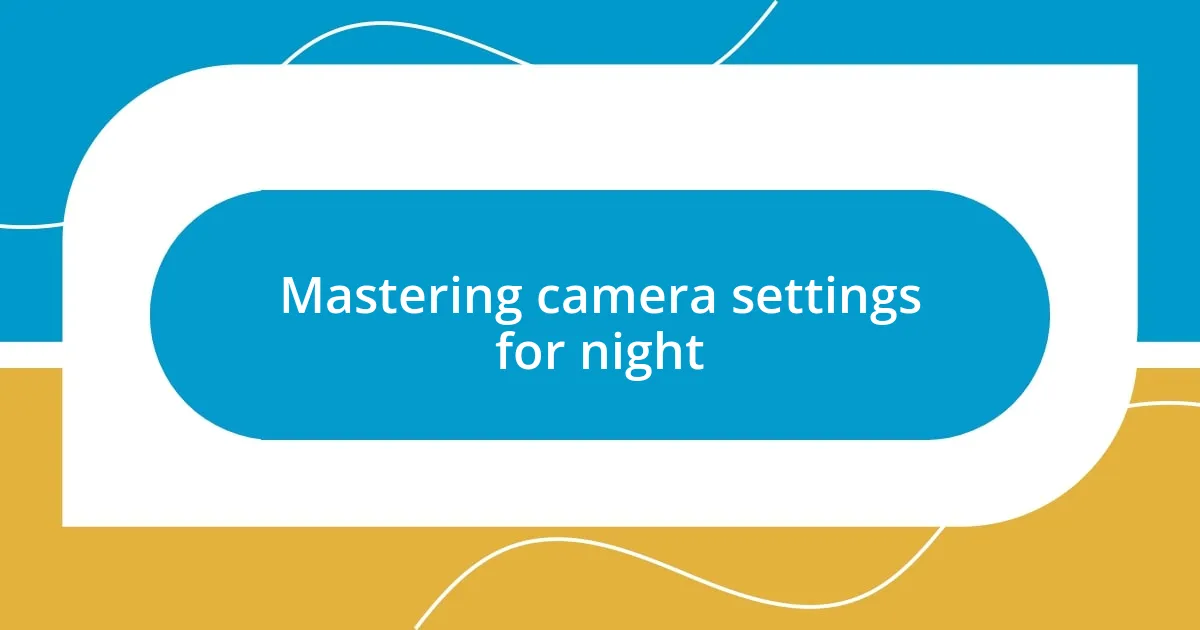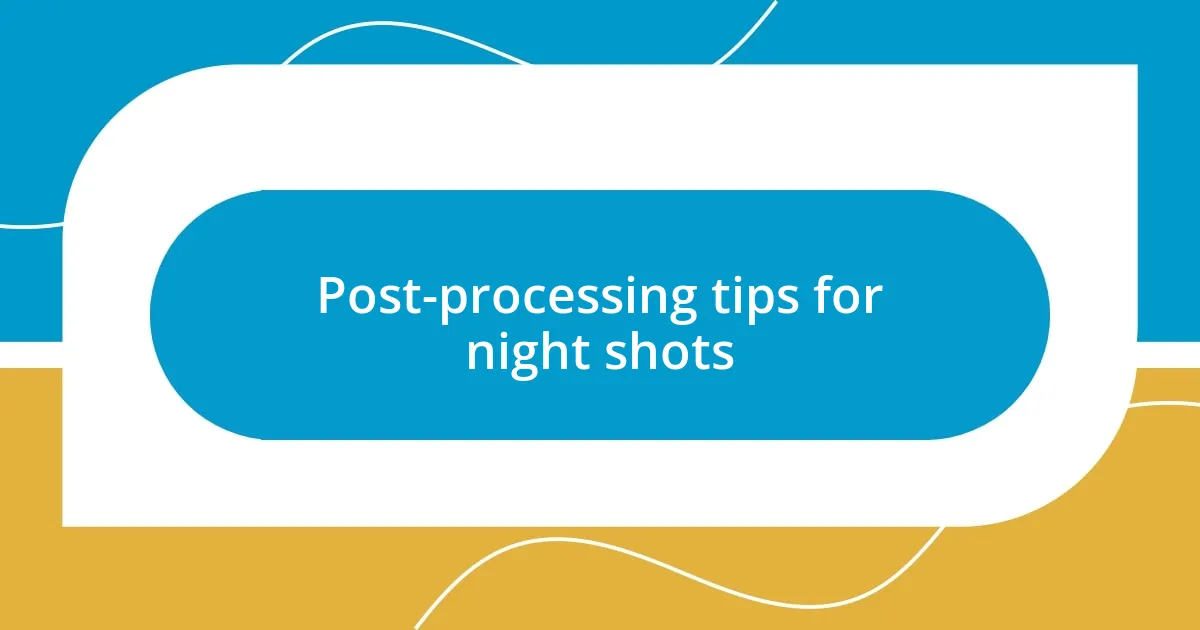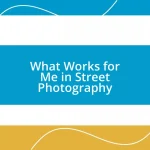Key takeaways:
- Nighttime photography requires understanding light manipulation, emotional connection, and equipment choice for captivating images.
- Master camera settings, including shutter speed and ISO, to enhance image clarity and dynamic effects in low light conditions.
- Post-processing techniques like noise reduction and color correction can significantly improve night shots, revealing hidden details and emotions.

Understanding nighttime photography
Nighttime photography has a unique charm that challenges the photographer to see the world differently. I remember my first late-night shoot under a starlit sky; the thrill of capturing that stillness was exhilarating. It felt like discovering a hidden world, where even the mundane transforms into something magical.
Understanding how to manipulate light is crucial in this genre. I often find myself pondering: how can a simple streetlamp ignite a scene with such warmth? The play of shadows and highlights creates a depth that daylight fails to reveal, inviting the viewer to explore every inch of the frame.
The emotional connection to nighttime photography can be deeply personal. For me, those quiet moments spent with my camera evoke a sense of introspection. What stories do the shadows tell? Each image becomes a canvas for my feelings, capturing not just what I see, but what I feel in that moment.

Choosing the right equipment
When it comes to nighttime photography, the right equipment can make all the difference. I once attempted to capture the Milky Way with just my regular zoom lens. The result? A blurry, uninspiring mess. I quickly learned that investing in a sturdy tripod, a fast lens, and a good camera equipped with manual settings is essential for achieving those breathtaking night shots.
Here’s what I recommend to have in your kit for nighttime photography:
- DSLR or mirrorless camera: Look for a model that allows for manual control and performs well in low light.
- Fast lens: A lens with a wide aperture (e.g., f/2.8 or lower) is ideal for letting in more light.
- Sturdy tripod: A solid tripod helps prevent any shake during long exposures.
- Remote shutter release: Prevents camera shake and allows for longer exposures without any movement.
- Extra batteries: Night shoots can drain batteries faster, so having backups is crucial.
Each piece of equipment not only serves a technical purpose but also offers a chance to connect more deeply with the environment you’re photographing. I fondly recall setting up my tripod under a dimly lit bridge, eagerly adjusting my camera settings. With each click, I felt as if I were unveiling a hidden story, one that might have gone unnoticed in the bustling daytime.

Mastering camera settings for night
Mastering your camera settings for nighttime photography can truly elevate your images. I remember my first attempt at capturing a city skyline at night. My initial settings were all wrong, leading to washed-out lights and blurry shapes. Gradually, I learned that using a low ISO (around 100-400) minimizes noise while extending exposure times allows more light to reach the sensor. Each time I adjusted my camera, it felt like piecing together a puzzle, revealing unique details hidden in the dark.
Shutter speed plays a critical role in night photography. I’ve often experimented with longer shutter speeds, sometimes exceeding 30 seconds, to create stunning light trails from passing cars. During one shoot, I set my shutter to 15 seconds and watched as the streetlights blurred into beautiful streaks of color against the night sky. This technique not only captures movement but also injects life into static scenes, turning ordinary moments into vibrant works of art.
Here’s a handy comparison of recommended settings for different night photography situations:
| Scenario | Suggested Settings |
|---|---|
| Cityscapes | ISO 100, Aperture f/8, Shutter speed 10-30 seconds |
| Star Trails | ISO 1600, Aperture f/2.8, Shutter speed 30 seconds and beyond |
| Light Trails | ISO 200, Aperture f/4, Shutter speed 5-15 seconds |

Techniques for capturing clear images
Capturing clear images at night often hinges on the little details, such as focusing techniques. On one particular outing, I remember standing beneath a vast night sky, trying to capture a sharp image of a distant star. Initially, I relied on autofocus, only to end up disappointed with fuzzy results. It wasn’t until I switched to manual focus, meticulously aligning my shot with a bright star that I finally achieved that crisp image. Have you ever felt the thrill of getting it right after struggling? It’s a feeling that every photographer craves.
In addition to focusing, composition is crucial for clear nighttime imagery. I often use the rule of thirds, placing key elements along these lines to create balance and draw the viewer’s eye. During one of my sunset shoots transitioning into night, I positioned a silhouetted tree on one side of the frame while capturing a glowing horizon on the other. This separation produced a compelling contrast that captivated viewers, making the scene more intriguing. Have you noticed how good composition can transform an ordinary photo into an extraordinary moment?
Lastly, patience is a vital technique in nighttime photography. Waiting for the right moment can be challenging, yet it’s often when magic happens. I vividly recall standing stock-still by a lake, watching as the moonlight began to dance on the water’s surface. I held my breath, knowing that any quick movement might ruin the shot. The moment I captured that serene reflection made the wait utterly worthwhile. It’s in these instances that you realize: sometimes, the most breathtaking images come to those who are willing to be patient and persistent.

Playing with light and exposure
Playing with light and exposure is like conducting an orchestra; each element must harmonize for a beautiful outcome. I still remember a night when I tried capturing the Milky Way for the first time. I was fascinated by how manipulating exposure time revealed magnificent colors and textures in the sky that were invisible to the naked eye. Did you know that increasing exposure can bring out the subtle details in dark areas? It’s such a simple adjustment, yet it can turn an average shot into something ethereal.
Experimenting with light can lead to unexpected revelations. One evening, while photographing an abandoned building, I used a flashlight to paint the building’s façade during a long exposure. A burst of creativity transformed that static structure into a lively scene, illuminating cracked walls and rich textures. Have you ever thought about how artificial light sources can add a layer of storytelling to your pictures? That’s when I truly understood that playing with light isn’t just a technical decision; it’s an artistic one.
Moreover, understanding the interplay between aperture and exposure is crucial. On a memorable night, I cranked my aperture wide open, allowing streams of light to flood in. As the city unfolded, every illuminated detail came alive, intensifying the scene’s emotion. It was thrilling to know that by controlling these elements, I was painting a picture that told a deeper story. How often do we underestimate the significance of these subtle changes? Each slight adjustment can evoke different feelings and draw the viewer into a world crafted by our visions.

Post-processing tips for night shots
Post-processing night shots can truly elevate your images, transforming them from a simple capture to a mesmerizing work of art. I remember my first experience with editing a starry sky; I was both excited and a bit terrified. The moment I adjusted the brightness and enhanced the contrast, the Milky Way erupted in vibrant colors right before my eyes! It’s amazing how a few tweaks can unveil details that were hidden in the darkness while keeping the night’s magic intact.
One key tip I’ve learned is to always pay attention to noise reduction. Night photography often introduces graininess, especially in high ISO settings. I vividly recall a breathtaking photo of a city skyline under moonlight, but the noise nearly ruined it. By experimenting with various noise reduction techniques in editing software, I learned to smooth out the image without sacrificing sharpness. Have you ever felt that thrill when a once-distracting flaw turns into a minor detail through careful editing? It’s like discovering treasure within your own work.
Don’t shy away from color correction, especially when working with artificial lighting sources. I was once faced with a photo that was overpowered by harsh yellow tones from streetlights. After a few adjustments in the color balance, I was able to restore the richness of the night sky and make the overall scene feel much more inviting. It’s incredible how color can evoke emotions; have you ever noticed how certain hues can completely reshape a viewer’s perception? Embracing post-processing is not just about fixing mistakes; it’s about enhancing the story you want to tell.














